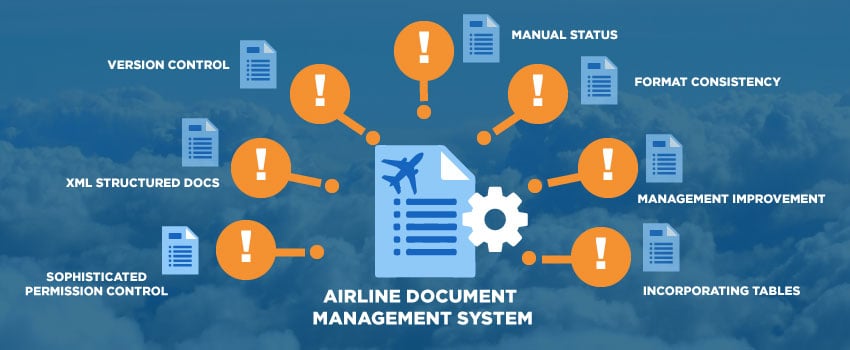
Great airline document management systems boost safety, efficiency and compliance. Managing mission-critical airline documents can become overwhelming for flight operations publishing teams if an effective system isn't in place. If you’re not using a document management system or your processes aren’t quite up to scratch carefully consider what would help.
In this article, we look at the benefits of document management systems and the different kinds of problems the right one can help solve for publishing managers. Read the article below to learn seven ways that document management systems can help.
1. Helps to manage structured documents
The better airline document management systems tend to be specially designed with PDF and XML in mind. More complex systems can also handle SGML and S1000D which provides front and back end users with very high levels of capability and stability.
As such, the use of this technology helps to speed up the process of editing manuals through automating routine tasks as well as providing functionality such as smart sharing of documents for review processes.
In addition, great document management platforms are able to leverage the power of structured data as the dynamic content provides the flexibility to change manuals with ease and advanced filtering capability provides end users with highly relevant information tailored to each context.
2. Consistency when formatting
One issue publishing managers might face when it comes to managing and maintaining manuals is a formatting one - especially where XML, SGML and S100D structure is concerned. Many airlines tend to have specific formatting requirements, as well as regulators who look for consistency with documents (especially as they have agreed an approved format).
The right document management system will be able to help publishing managers and their team ensure there is consistency when amending documents. This area is critical for regulatory approval of certain manuals.
3. The ability for sophisticated user group permissions
Whether you’re still using paper or even digital versions of airline documents it’s crucial that only the right people have access to them. However, this can easily go awry if you have multiple versions of documents flying around everywhere - just about anyone can get their hands on information they shouldn’t be seeing.
Document management systems, on the other hand, tend to have much more security built into them - which includes user group permissions. The more sophisticated you can set these up, the better the system. These permissions will ensure that only the right people can access the right document at the right time.
4. Archiving and version control
There will always be a requirement to update manuals on a regular basis due to OEMs such as Airbus and Boeing releasing amendments throughout the year. As such, it means the need for extra resources to assist with pushing the amendments of manuals through - however, there is a risk here if your document management processes and software isn’t up to scratch. With more employees needing to work on manuals, there is a greater risk of error.
The more sophisticated document management systems employ complex comparison tools that are able to track and highlight changes between old and new documents. For Airbus and Boeing this facility is not only invaluable but the catalyst for efficient and costs effective updates. It is rare for in-house teams to have such editing support.
5. Showing status of manual changes/updates
As flight operations manuals might consist of hundreds of pages, the amends could be extensive when updates are released. As such, it could be hard for publishing managers to monitor the status of manual changes and how far they are from completion.
The right document management system could solve this issue by providing a dashboard overview of all manual amendments currently in play and the changes that have been made. This is often considered a key time and resource reducing aspect of a good document management system.
6. Improved management and distribution of information
Modern document management systems are purposefully built to provide a more centralised network for all collaborators. This is particularly useful because it vastly improves how information is managed between different parties, and indeed ensures distribution of the final manual becomes much more efficient. Additionally, there is also the benefit of collaborators being able to work on and share documents simultaneously, which is particularly important for technical pilots (SMEs).
7. Incorporating tables
Tables can be particularly cumbersome in XML, SGML and S1000D structured documentation, especially as it requires a certain level of accuracy with a large amount of information that may need amendments. While identifying changes in individuals cells might seem straightforward, more complicated actions such as manipulating rows and columns, merging of cells and more could prove much more difficult - one wrong move and the structure of the document could become compromised.
It should be noted that this is one of the most complicated areas of airline document publishing and one where formatting and consistency are difficult to achieve even with the best document management system. It is in this instance where expert publishers are invaluable.
Conclusion
As airline documents and manuals become ever more complex due to the constant evolution of aircraft technology, managing the documents themselves become more difficult. This means that publishing managers will be facing more challenges with documents - and if you don’t have the right system in place, it could affect your whole process.
The right document management system should be able to help solve your challenges, instead of creating new ones that can cost a loss of resources and time as well as causing a few headaches. If you’re looking at choosing a document management system that will better suit your requirements, then why not read our useful guide. In it, we discuss how best to approach choosing a document management system that will benefit your publishing team and organisation as a whole.


